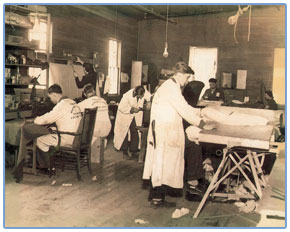I’m delighted to announce that New England’s premier bedding manufacturer, Gardner Mattress, has agreed to donate custom mattresses for the FDR Suite bedrooms. While this may not sound like a world breaking-news event, finding a qualified company to make mattresses for our period beds had turned out to be quite a challenge.
Why, you ask?
As Gardner Sisk, President of Gardener Mattress explained to me over lunch today: “Years ago, mattress sizes weren’t standardized. You bought a mattress when you bought a bed, and it was specifically made for that frame, whatever its dimensions. Then, after a few years, as the support began to go, you called the maker, who removed your old mattress, re-stuffed it for you, and returned the same piece, door to door. You could literally go from cradle to grave on the same bedding.”

The Gardner factory in the 30's. Interestingly, custom quality mattresses even today are largely the creation of hand labor.
Hmm. Given what we today know about dust mites, etc. I won’t even comment on that…
In any event, true to period form, our two FDR bed frames – one (FDR’s) in high Eastlake Style, the other (Lathrop’s) in very early Arts and Crafts – were of two different mattress types, each different sizes, and requiring different support mechanisms. As Mr. Sisk carefully measured the intricate frames, and explained to me how they put together this period appropriate bedding, I became quite intrigued. For something so quotidian, it turns out mattresses are quite complex mechanisms with a fascinating history, and I’ve decided to take a trip up to Gardner’s Salem, Massachusetts factory to document the manufacture of our beds as they come together in mid-July.
Interestingly, the Gardner company has an FDR connection, at least chronologically: the corporation was founded in 1933 by Alan J. Gardner at the height of the Depression, and has thrived almost 80 years by becoming innovators of the finest quality mattresses and box springs on the East Coast.
Can’t wait to try them out! Nor can you, I bet.
Coming this July, to the FDR Suite. (Deo volente!)

in France, one of the prides of a traditional household is the bedding. Typical old-style or country mattresses are stuffed with wool. My dry cleaner in Paris has a sign up advertising a one-day full renovation: they unsew the edge of the mattress (remember that nice beige-striped heavy cotton material from all your old summer house mattresses?), pull out the wool, wash it, dry it, fluff it up and re-insert it. As for the geometrically-placed big transversal stitches with tufty pompom extremities that pucker the mattress and keep the wool evenly distributed, I’m not sure whether these are uniformly removed and replaced, or just renovated as needed.
My mother-in-law, of peasant stock from the Pyrenees, attaches great importance to this type of bedding, and is very proud when every few years she launches a renovation. In the old days each village had someone who did this work (whether creating or renovating the mattress), or it was one of the many tasks that women took care of in community effort. They washed the wool in the stream and let it dry in summer sun on tops of hedgerows or bushes.
I would suspect that natural lanolin is something that both keeps dust down and inhibits mites. It does linger a very long time- decades (I was sniffing just today a sweater of thick undyed wool yarn that my aunt knit about 40 years ago and that I have hand washed many times, and it still does smell like a very pleasant sheep.)
I don’t know about springs (except in the lower box assembly), France did not necessarily move through that evolutionary stage on the way to modern white factory mattresses.
How cool! I’m telling you, there are more to mattresses than meets the eye!